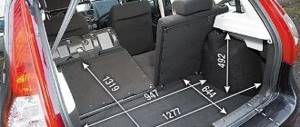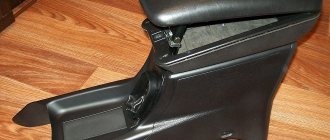With modern capabilities, the range of the current automobile industry is trying to please any, even the most capricious client. The Lada Vesta model range is proof of this. The layout and volume of the trunk are often important for car owners; all people pay attention to such details. Especially planning that the car will often be used to transport large cargo. The buyer has an individual list of criteria for choosing a car. The Lada Vesta model under consideration, in particular the SV cross version, is positioned as a universal car, its trunk volume is large and can accommodate a lot of things.
- Trunk of station wagon and Cross version - interesting observations
- The layout of the car trunk - the convenience of the organizer
- Sedan trunk volume
- Trunk of the CNG modification - why can’t you put a lot in it?
- Are the luggage racks better than competitors?
Trunk of station wagon and Cross version - interesting observations
Automotive designer Steve Mattin, who works at VAZ, claims that when creating the Vesta Sw station wagon, they designed a rear window model with a slope, which directly affected the volume of the trunk. If a station wagon is maximally identified with a sedan, then the trunk volume of the Lada Vesta SV Cross is almost the same, amounting to 480 liters. Removing the raised floor reveals an additional 95 liter compartment. In this parameter, the Cross version of the car does not differ from the Sw.
Transportation of large cargo is required; just fold the rear seat and we get a trunk compartment with a nominal capacity of 825 liters. The key parameters of the trunk opening are width and height. The first is 1000mm, and the second, respectively, is 860mm.
The dimensions of the trunk of the Lada Vesta SV are as follows (a×b×h): - shortest length (close to the rear seat) - 930 mm;
- largest (a) (close to the front seat) - 1820 mm;
- smallest (b) (between arches) - 980 mm;
- largest (b) (including 2 niches) - 1340 mm;
- largest (h) - 830 mm;
- smallest (h) - 660 mm;
- (h) threshold - 110 mm.
They are similar for the station wagon and Cross version.
LADA Vesta SW – Technical characteristics – Official LADA website
- 980 mm – width between wheel arches;
- 1340 mm – width with two niches;
- 930 mm – length of the compartment to the back of the rear seat;
- 1820 mm – length to the front seat;
- 660 mm – height above the top of the folded rear seat;
- 830 mm – height above the top of the folded rear seat excluding the cushion;
- 110 mm – threshold height.
In the trunk of the Lada Vesta Cross Station wagon there are niches and nets with which the cargo is secured. In addition, the designers equipped the compartment with a practical organizer; it usually houses various small items necessary for the driver. The organizer drawers stow away to maximize available space, and the spare tire fits easily in the double bottom.
The trunk volume of the Lada Vesta station wagon reaches 480 liters. An additional 95 liters are found in the double bottom. Access to the luggage compartment is provided by a button located on the fifth door.
Disadvantages include large hinges that take up a lot of space, and the lack of standard means for securing transported cargo.
- Body
- Wheel formula / drive...
- Body type / quantity...
- Length/width/height by antenna,…
- Front/rear wheel track,…
- Luggage compartment volume in passenger/cargo…
- Engine
- Quantity, location...
- Maximum power, kW (hp) / rev….
- Maximum torque, Nm / rev….
- Dynamic characteristics
- Maximum speed, km/h
- Acceleration time 0-100 km/h, s
- Fuel consumption
- Extra-urban cycle, l/100 km
- Weight
- Technically permissible maximum weight...
- Maximum trailer weight without brake system /…
- Transmission
- Main gear ratio...
- Suspension
- Steering
- Tires
- 1.6 l 16 cl. (106 hp), 5MT
- station wagon / 5
- 5
- 4410 / 1764 / 1508
- 2635
- 1510 / 1510
- 178
- 480 / 825
- 21129
- petrol
- 4, in-line
- 1596
- 78 (106) / 5800
- 148 / 4200
- gasoline 92
- 178
- 12,4
- 9,5
- 5,9
- 7,3
- 1280…1350
- 1730
- 600 / 900
- 55
- 5MT
- 3,9
Now we come to the most interesting part - the technical component. Of course, as is the case with trim levels and options, the station wagon’s engines are identical to those of the sedan. These are two sixteen-valve power units with a volume of 1.6 and 1.8 liters and a power of 106 and 122 hp. respectively.
The second option turned out to be quite dynamic, especially in combination with mechanics. By the way, both engines are equipped with two transmissions to choose from - classic mechanics and a robotic automatic.
| Parameter | Lada Vesta SW 1.6 106 hp | Lada Vesta SW 1.8 122 hp | ||
| Engine | ||||
| Engine code | – | – | ||
| engine's type | petrol | |||
| Injection type | distributed | |||
| Supercharging | No | |||
| Number of cylinders | 4 | |||
| Cylinder arrangement | in-line | |||
| Number of valves per cylinder | 4 | |||
| Volume, cubic cm. | 1596 | 1774 | ||
| Power, hp (at rpm) | 106 (5800) | 122 (5900) | ||
| Torque, N*m (at rpm) | 148 (4200) | 170 (3700) | ||
| Transmission | ||||
| Drive unit | front | |||
| Transmission | 5 manual transmission | 5 manual transmission | 5 manual transmission | 5 manual transmission |
| Suspension | ||||
| Front suspension type | independent MacPherson type | |||
| Rear suspension type | semi-dependent | |||
| Brake system | ||||
| Front brakes | disk | |||
| Rear brakes | drums | disk | ||
| Steering | ||||
| Amplifier type | electric | |||
| Tires | ||||
| Tire size | 185/65 R15 / 195/55 R16 | |||
| Disk size | 6.0Jx15 / 7.0Jx16 | |||
| Fuel | ||||
| Fuel type | AI-92 | |||
| Environmental class | Euro 5 | |||
| Tank volume, l | n/a | |||
| Fuel consumption | ||||
| Urban cycle, l/100 km | n/a | n/a | n/a | n/a |
| Extra-urban cycle, l/100 km | n/a | n/a | n/a | n/a |
| Combined cycle, l/100 km | 7.3 | 7.0 | 7.8 | 7.6 |
| Weight | ||||
| Curb (min/max), kg | n/a | n/a | n/a | n/a |
| Full, kg | n/a | n/a | n/a | n/a |
| Maximum trailer weight (equipped with brakes), kg | n/a | n/a | n/a | n/a |
| Maximum trailer weight (not equipped with brakes), kg | n/a | n/a | n/a | n/a |
| Dynamic characteristics | ||||
| Maximum speed, km/h | 174 | 174 | 180 | 182 |
| Acceleration time to 100 km/h, s | 12.4 | 14.4 | 10.9 | 12.9 |
Previously, West sedans were equipped with French mechanics, but then they decided to abandon them in favor of domestic development. The engines do not suffer from a lack of traction, which is sufficient throughout almost the entire rev range.
True, the 1.8-liter engine will still be more powerful. Otherwise, everything turned out soft and at the same time cheerful. There is only one unpleasant moment left - this is the gluttony of the engine, which AvtoVAZ could not moderate. The engine consumes on average 10 liters per 100 km.
The layout of the car trunk - the convenience of the organizer
The main role in the ease of use of the luggage compartment is played by a thoughtful layout of the space. The SV Cross station wagon is well equipped. Car enthusiasts are interested in a double floor with a box built into the trunk for various small items needed by the driver. The trunk organizer is a new solution; it wasn’t installed anywhere before 2180! This niche consists of two plastic drawers, which are covered with floor panels. Each section is fixed vertically, which allows you to zone the available space separately. The floor panels and organizer are removable, increasing the cargo capacity.
The cargo transported in the trunk of the Vesta SV cross can be secured; for this purpose, three nets are provided. The side panel on the right provides an irreplaceable detail - a lockable tool box, and on the left - a pocket that can accommodate a 5-liter bottle. There are four hooks on the trunk upholstery for various packages. The spare tire is located under the second floor and does not take up space. For lighting, there are two light bulbs on the sides, and a 12-volt socket is provided. For easy access, there is a button for opening on the outside of the trunk lid, and two handles inside. The luggage compartment of the Lada Vesta SV Cross is designed and equipped for easy operation.
Dimensions and capacity of the trunk
Another important difference between the Vesta SW Cross and the sedan is the dimensions and functionality of the trunk. It was equipped with special fastenings and drawers for storing various small items. There are also two removable trays located under a cover in the floor, their size allows you to keep many useful tools and snow brushes there. It is under these containers that the spare wheel with a stamped disk is located.
Photo source: https://www.avtogide.ru/wp-content/uploads/2017/09/4-21.jpg
If you fold the rear seat backs, you can increase the volume of the luggage compartment to 825 liters, while in the standard position the volume from the raised floor to the curtain is 385 liters. The maximum length that can be achieved if you need to transport something long and at the same time close the trunk door is 1820 mm to the back of the front seat, moved forward.
Sedan trunk volume
The luggage compartment capacity of the Lada Vesta sedan is 480 liters. The standard equipment includes a flat floor covering with a hidden niche for a spare wheel. Thanks to the larger track width, the wheel arches do not protrude inward, and the dimensions of the trunk allow you to freely place fairly large loads. The trunk lid with increased opening amplitude is an advantage. Compared with the functional trunk organizer of the Lada Vesta SV Cross, the standard layout of the sedan noticeably loses in ease of use.
Disadvantages of the trunk of the Lada Vesta SV Cross
The disadvantages of the car include the poorly thought-out double floor of the luggage compartment. The high threshold formed when the door is opened deepens an additional 15 cm, which complicates the loading of heavy objects. Thus, manipulations have to be carried out exclusively with the step - this imposes additional inconvenience when working with large loads. The next drawback is the incomplete folding of the seats. The backrests of the structure recline at an angle of 55˚. Therefore, packing long items will be problematic. In some exceptions, buyers complain that after heavy rain or pressure washing, water gets into the trunk of the Lada Vesta. Such problems are normal for the manufacturer and are considered normal among users. In this case, experts recommend contacting a service center to replace the seals. If the factory service period has expired, the cost of a new rubber band starts from 1000 rubles. In more severe cases, leaks form at the joints of windows. Here you also need to contact the seller to obtain warranty repairs or fix the leak yourself. The work of re-gluing a window will cost the car enthusiast about 5,000 rubles.
Trunk of the CNG modification - why can’t you put a lot in it?
The factory's response to the current situation with a constant increase in fuel prices, in 2020 AvtoVAZ is launching a new model of the Lada Vesta CNG sedan on the market. A special feature of this modification is the ability to use gasoline and gas as fuel. Accordingly, the car is equipped with a gas cylinder installation. The luggage compartment was considered an acceptable place for a 90-liter methane cylinder. As a result, the volume of the trunk has been significantly reduced - its useful volume is 250 liters , the cylinder has a bad effect on the volume of space and convenience.
Lada Vesta: trunk description
So, Lada Vesta. Its load capacity is 440 kg. For comparison: the Volga’s carrying capacity is 80 kg less. For Skoda Rapid it is 505 kg. Car owners have noticed that a loaded Lada Vesta drives better and smoother than a free one. It is possible to install an external roof rack on a sedan. The model does not include an external trunk; it must be purchased separately. Permissible load – 50 kg.
Now let's move on to the luggage compartment inside the car. It can be opened from the passenger compartment, either with a key or remotely. The size of Vesta’s trunk turned out to be quite spacious, 480 liters. A well-fed adult man can calmly take a nap in it, especially since the spare tire does not absorb its useful area, and a soft sound-absorbing mat is laid on the floor. In general, the entire rear compartment is lined with felt. But the rug, of course, is lifted and removed to shake out dust and debris. The advantage of such cladding is that it breathes, allows air to pass through, and therefore will not accumulate condensation. The downside is the felt fibers that remain everywhere they come into contact.
The spare tire is miraculously located under the rug, in a separate box. This also accommodates a tool organizer that is installed in the disk space, and wheel chocks will fit nearby. Near the wheel you can store other utilities necessary for servicing the machine itself, for example, a small jack. Thus, while filling the trunk to capacity, the car owner will not have to leave the spare tire at home or place it in the cabin.
The rear of the Lada Vesta really turned out to be spacious and proportional. Volume is achieved by the following factors.
- The wheel rims protrude slightly inside, almost without eating up the width of the body, and thus large objects can be placed inside the car.
- The bottom of the luggage compartment is also flat.
- If you fold the rear seats, objects up to 3 meters long will fit inside.
What to pay attention to
True, there was one minor drawback - the folded seats do not extend the trunk floor, but form a threshold. But the seats fold individually and easily, increasing the size of the luggage compartment. And the low threshold edge of the body and the wide opening of the cargo compartment make loading and unloading convenient. On the trunk lid, which rests against the bumper, a part of the light optics and a number are attached.
Are the luggage racks better than competitors?
When considering the volume of the trunk as one of the criteria for choosing a car, it is worth considering what dimensions other brands have. We assessed the closest competitors of the Lada Vesta SV Cross for spaciousness:
- Hyundai Solaris - volume is 370 - 480 liters, depending on the model and generation;
- Volkswagen Polo: 280 - 460 l;
- Hyundai Accent - from 334 to 480 hp.
Taking into account the double bottom, the luggage compartment volume of the Lada Vesta SV Cross is larger than that of competitors and fellow models of the model range.
General conclusions and practical assessment
The compact trunk of the LADA SW Vesta is somewhat inferior in capacity and volume to other competitors in this class. However, due to the proper organization of space and the ability to conveniently use all functions, the car gained high marks from car enthusiasts.
Thanks to the folding rear row, the car is perfect for transporting large cargo and tourist trips. Therefore, many analysts and specialists are confident that the SV version can become a priority for the domestic market in 2020.
Check out our VKontakte group.
Looking back to the past
The Lada Kalina hatchback has a volume of 260 liters, the Priora - 360. The latest model went on sale back in 2007. The Lada Priora station wagon is equipped with 444 liters of luggage space. The Largus models with a trunk volume of 560 liters surpass this parameter.
The back of the rear sofa of the new product can be folded, which increases loading possibilities. Also on Lada Vesta cars, the trunk volume of which is becoming increasingly important, sound insulation will be improved. Buyers also hope for a fully upholstered cargo area. The trunk of the Lada Vesta is much larger than that of the Priora. In addition, the ease of use will remain high, and it will become less dirty.
The price for the new Lada Vesta will start at 514 thousand rubles - this is the minimum announced by AvtoVAZ director Bo Andersson.
More details about Lada “Vesta” cars
Comparison of Vesta with other models of modern AvtoVAZ cars
For comparison, here are some numbers regarding the trunk.
But in both the sedan and station wagon, the seats conveniently fold forward, thereby increasing the volume of the luggage compartment by 250-300 liters, respectively.
| Lada models | Cargo compartment characteristics | Parameters in other cars |
| At the Vesta sedan. | The volume of the cargo compartment is 480 liters, | This is the same as Renault Logan. It should be noted that Vesta’s luggage compartment, the shape of the hinges on the lid, and the lid itself have a common outline with the Renault Logan sedan. |
| The predecessor of Vesta is the Lada Priora. | The size is 430 liters. | The Daewoo Gentra has the same luggage capacity. The leaders in luggage capacity are the Hyundai Solaris and Skoda Rapid, having a space of 510 and 530 liters, respectively. The Datsun on-Do has an equally capacious trunk. |
| The cargo part of the Lada Vesta station wagon model, the release of which is still awaited by all fans of AvtoVAZ cars. | It will accommodate, according to the developers, 500 liters of cargo. |
The luggage compartment of the Lada Vesta in the hatchback assembly will be significantly smaller - only 400 liters.
Comparison of trunk parameters with other Lada models
To compare the capacity parameters, consider other AvtoVAZ models:
- Vesta's predecessor, Lada Granta (sedan) has 520-liter luggage space. Folding the seat backs increases the volume to 840 liters. Parameters of Grants in a hatchback body – 440 liters and plus 320 liters when access to the interior is opened. Grants in the station wagon body have the smallest volume, which is 355 (670) liters.
- The internal luggage space of the Lada Priora sedan is 430 liters, the station wagon – 444 liters, the hatchback – 360 liters.
- Lada Kalina has parameters: 240/550 (hatchback), 355/670 (station wagon)
- The Lada Largus station wagon can accommodate up to 2350 liters of luggage, and the van body is even larger - 2540.
New Lada: Lada Vesta on-board computer - menu functions and secrets
As you can see, the last point especially stands out in this list due to the fact that Largus was created for the transportation of bulk cargo. The other models are approximately at the same level, and Vesta is only ahead of Grant by 40 liters.
What will the new Vesta please you with?
An important characteristic of the trunk is the layout of the space. Lada Vesta, whose trunk volume has increased significantly in recent years, provides the buyer with a design with a completely flat floor. There is space underneath for a spare tire. Thanks to the wide opening, loading large cargo is easy. It is worth considering cars with 3 body types:
The trunk of the future Lada Vesta station wagon especially stands out. It is expected to increase to 500 liters. The slope of the rear window above the trunk smoothly merges into the bumper. This expands the machine's load capacity.
Vesta Cross offers motorists a convenient luggage compartment with a curtain, smooth side walls and mounting rails. The protective finish on the threshold allows you to load heavy items without fear. The trunk volume is expected to be between 500-520 liters. You can appreciate its parameters from the presented photos.
The luggage compartment of the Lada Vesta hatchback, judging by the performance characteristics of its main competitors, will be equal to 400 liters. It is planned to include a lock with an electric drive in the package. The headlights are conveniently located on the opening luggage compartment lid.
Salon Lada Vesta SV cross
Since the cross body car came out at the end of '17, its interior is no different from the '18 car. Both the driver and the passenger feel comfortable sitting in the Cross. Many people are interested in the question of whether the Lada Vesta has 7 seats, the answer is: it doesn’t, there are no 7 seats in the interior of the crossover, there are only 5 of them.
Let's start with the Cross steering column; outwardly it is no different from the steering wheel of a Vesta sedan - all the same buttons for controlling the multimedia system. However, there are differences: in any configuration of the Vesta Cross, the steering wheel is covered with leather.
Photo of the interior of the cross modification
The central panel is no different from the sedan, everything is still harmoniously located in its place, which makes driving easier. There is a glove box mounted on the panel on the right; it has a decent volume. In the center of the cabin there is a central tunnel with cup holders and a gear knob. The handle of the box depends on what kind of box is on the car.
After the gearbox there is an armrest, convenient for the elbow of the right hand. The plastic in the cabin is the same everywhere, in the door cards and on the dashboard. Door cards have harmonious inserts that highlight the design. The doors have spacious containers in which you can put small things or a bottle of drink. Overall the door finish looks decent. Each door has its own electric lift, and the driver's window control unit with rear door locking and mirror adjustment.
The Vesta Cross floor is carpeted everywhere. It can be called a classic flooring material in many foreign cars and vases. The ceiling on Vesta Cross is light, but it is made with high quality; in case of contamination, the dirt can be easily washed off.











